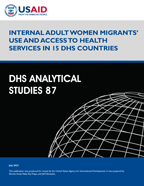There is no printed copy available to order.
Abstract:
This report uses Demographic and Health
Survey data from 15 countries to examine
internal migration of adult women age 18–49
between rural and urban areas and its
relationship with access to and use of health
services. The analysis includes the study of
migrants’ characteristics, trends in
migration, and the relationship between
migrant status and four outcomes related to
access and use of health services. These
outcomes are having at least four antenatal
care visits, using modern contraceptives,
having a major problem accessing health care
for self due to obtaining money needed for
treatment, and having a major problem
accessing health care for self due to
distance to facility. Migrant status included
rural to urban migration and vice versa,
while also distinguishing between recent (<3
years) and non-recent (3 to 9 years)
migrants. The highest levels of rural to
urban migration were found in Nepal, Kenya,
Bangladesh, and South Africa (12 to 18%), but
there were also high levels of urban to rural
migration in Uganda and the Philippines (both
at 10%). There were some moderate but
statistically significant changes in
migration levels as described in the trend
analysis. Recent migrants were more likely to
be young (age 18 to 24) and not currently in
a union, while all migrant types had higher
education than rural non-migrants. For the
relationship with the outcomes, we find that
there were few statistically significant
findings for antenatal care (ANC) and modern
contraceptive use outcomes. However, when
there was statistical significance, the
disparities by migrant status were often
large, which warrants further country
specific research. We also see some evidence
of adaptation with disparities found between
recent migrants and non-migrants, but no
statistically significant difference between
non-recent migrants and non-migrants.
Overall, the largest and most consistent
differences in the outcomes were found
between those residing in urban or rural
areas, regardless of duration
of residence.
 Internal Adult Women Migrants' Use and Access to Health Services in 15 DHS Countries (PDF, 1780K)
Internal Adult Women Migrants' Use and Access to Health Services in 15 DHS Countries (PDF, 1780K)
 Internal Adult Women Migrants’ Use and Access to Health Services in 15 Countries (AS87) - Analysis Brief
Internal Adult Women Migrants’ Use and Access to Health Services in 15 Countries (AS87) - Analysis Brief
